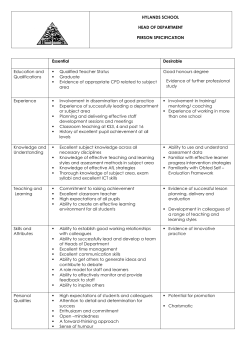
to briefing - Anti Academies Alliance
Anti AcademiesAlliance ‘Free Schools’ briefing “Agood localschool forevery child” April 2015 David Cameron’s announcement that the Tories will expand their free schools programme is an illustration of the bankruptcy of neo-liberal politics – or what, in education, we call the ‘GERM’ – the Global Education Reform Movement. The central belief of GERM is that choice and competition will drive up standards. The trouble is that there is no evidence it has done so or will do so. Indeed the experience of Sweden suggests that an education market has the opposite effect. Results, except for a minority of children, seem to get worse. The Tories’ free schools policy has already failed to deliver improvements. Academics, teachers and their unions, are scathing of the programme even if some individual free schools have done well or opened in areas of need. And it’s common knowledge that some free schools have failed spectacularly. Perhaps the crucial question is how – in a time of cuts and austerity – can government justify spending money so randomly on a tiny percentage of schools? Free schools account for less than half a percent of all schools yet the Tories want to spend even more public money on them. Moreover, the allocation of resources to free schools is entirely random and based on the wishes of a small number of parents or businesses. If education was awash with money and there was not a serious school places crisis then perhaps this Picture: © Paul Box/reportdigital.co.uk Free Schools– show us the evidence! could be justified. But the Tories’ policy puts ideology before children’s need. According to recent You Gov surveys, 80% of parents are opposed to more free schools. Most parents aren’t interested in markets, choice, corporate branding and phony neo-liberal ideology. They simply want a good local school for their children. The Tories say they care, but their free school policy shows they don’t. It’s time to allow free schools to join their local authority. Four out of every five primary schools are still LA maintained and according to Ofsted they are thriving. This model works. >>> Anti AcademiesAlliance Free Schools don’t raise standards The Tories and sponsors of free schools suggest that free schools out-perform other schools but the evidence simply isn’t there. Ofsted has inspected 76 free schools and rated 30% as ‘Requiring Improvement’ or ‘Inadequate’. Ofsted’s 2013/14 Annual Report on Schools said: ‘free schools succeed or fail for broadly the same reasons as all other types of school’. In other words: free schools are no more likely to be outstanding or inadequate than other schools. The Tories used a report – A Rising Tide – from the Policy Exchange (a free market think tank founded by Michael Gove) to justify their Free School programme. Even this report admits: ‘It is ... not possible to draw any real conclusions – positive or negative – as to the effects of Free Schools from ... results so far’. What we do know from a 2013 National Audit Report, though, is that more than one in ten teachers working in Free Schools are unqualified yet only one in ten respondents to a You Gov survey agreed that academies and free schools should be allowed to employ unqualified teachers. We’ve also seen some devastating examples of the education provided by free schools. Early in 2015, the Durham Free School was put into special measures by Ofsted and its funding agreement terminated – the school will close. Yet it had been praised by the free schools architect, Michael Gove, as a school that would improve education in the North of England! Now it’s a disaster for children, their parents and school staff and exposes the risk at the heart of a policy where parents are treated as consumers and school places as commodities. The day after the announcement on Durham Free School, another free school – Grindon Hall, previously an independent fee-paying school – was put into special measures after Ofsted condemned the school’s leadership for not safeguarding pupils or tackling “prejudice-based bullying”. In 2014, Ofsted criticised teaching and pupil achievement at Greenwich Free School as below standard. The same year IES Breckland – England’s first for-profit free school – was put into special measures when serious concerns were raised about the safeguarding of children and special needs provision. In 2011, a free school opened in Crawley but was closed two years later when Ofsted warned that the headteacher lacked the skills and knowledge to improve teaching, special needs provision was inadequate and there was a risk of children leaving the school unable to read or write. Free Schools aren’t accountable In Bradford, the founder and former principal of a free school has been charged with fraud along with two other members of staff. This free school gained notoriety when it was revealed that a vice chairman of the Conservative Party had been paid hundreds of thousands for the school’s site. He denied that he was also chair of governors at the free school. The free school model, based on private sector ideology and motivation, poses huge risks to public money. Free schools are publicly funded but approved with no local democratic accountability. They are run by small unelected boards and given considerable freedoms over who they employ, what they teach and how they spend public money. Concerns over the management of free schools are increasing. A recent Public Accounts Committee report concluded: ‘Recent high-profile failures ... demonstrate that the ... oversight arrangements for free schools are not yet working effectively to ensure that public money is used properly’. The Committee’s Chair, Margaret Hodge MP, said: ‘We also have concerns over standards of governance in some free schools.’ Free Schools don’t just not do any good – they may do harm Advocates for free schools argue that the competition created by opening a free school improves the performance of all schools in an area. But the data simply doesn’t support this argument. Overall the changes in results at schools closest to a free school are remarkably similar to the changes of all schools nationally. The Local Schools Network compared the increase in results at primary schools ‘Free Schools’ briefing Picture: © Timm Sonnenschein/reportdigital.co.uk “Agood localschool forevery child” close to free schools with the national average at the time the free school opened. This analysis showed virtually no difference in results. Indeed, the only year for which a difference can be seen shows that results were slightly worse for schools closest to a free school! Similarly there is virtually no difference between the change in results at secondary schools close to free schools and secondary schools nationally. For 2012 and 2013 openers, the change in GCSE results is exactly the same and for 2014 openers there is just a 1% difference. 6% Free Schools are divisive Free school pupils are, generally, less likely to be entitled to free school meals than pupils in neighbouring schools, and less likely to have English as an additional language than pupils in neighbouring schools. This divisiveness is confirmed by the University of London's Institute of Education that found that many primary-age free school children are less disadvantaged than average and tend to have high levels of prior attainment. The government continues to reject accusations that free schools are the preserve of the urban middle-classes but as the Association of Teachers and Lecturers commented: ‘Free schools have brought in selection by the back door and become the elite institutions we feared they would be- dominated by children with the pushiest parents.... even where free schools have opened in deprived areas they are still not taking the most disadvantaged children.’ Free Schools drain the budget for other schools In 2014 an enquiry into free schools revealed that there were no applications to open primary free schools in areas with a high or severe forecast need for extra places. Less than a fifth of places at secondary free schools opened, so far, have been in areas of high or severe forecast need. These findings confirm those of a 2013 report that found 42 free schools had opened in areas with no forecast need, with estimated total capital costs of at Increase in Key Stage 2 Results to 2014 5% Schools closest to Free Schools National average 4% 3% 2% 1% 0% 2011 2012 2013 2014 least £241 million out of a projected total of £950 million for all mainstream schools. Last year, an analysis by the Labour party estimated that 17,500 extra places could have been provided if free school places had been allocated only to areas of need. The same report found that 70% of free schools were still not full, two years after opening, and so 1,500 empty spaces were being funded in these schools. The Tories say it’s acceptable to cut sixth form college funding, ration funding for school repairs and rebuilding, hold down pay for school staff or close children’s centres because of the need to cut public spending. But the free school programme overspent by 300% and more than £1 billion had to be found from the school building and other education budgets. At £6.6 million per free school, the average unit cost of premises is more than double the original assumption. Despite concerns from civil servants, Michael Gove approved plans to spend £45 million on the Harris Westminster Sixth Form sponsored by the Harris Federation. Lord Harris is a former party treasurer who has donated millions to the Tories. Bolingbroke Free School in Battersea, opened by Lord Fink’s Ark academy chain, received £25.95 million just for site acquisition and construction costs. Even Lib Dem Minister David Laws, now admits that the Tories’ plans for 500 new free schools would mean ‘a £4 billion raid on other budgets, consigning children and teachers to crumbling classrooms and leaving some without a school place at all.’ Who sets up free schools? Government spin says it’s local parents, teachers and charities who set up free schools but these can be a cover for religious groups or businesses who want a slice of the action. In the March 2014 TUC study ‘Education Not for Sale‘, Warwick Mansell and Martin Johnson explained that existing academy sponsors are the largest category of bidders making it to interview stage with the percentage >>> Anti AcademiesAlliance PO Box 5408, Brighton BN50 8HB Twitter:@antiacademies Facebook: Anti Academies Alliance Email:office@antiacademies.org.uk Website: www.antiacademies.org.uk >>> of proposals from parents, communities and teachers falling from nearly 50% in 2011 to less than 25% in 2013. And an analysis of the websites of the 153 free schools due to open in September 2015, and beyond, reveals only around 10% of these free schools are proposed by parent groups. Before the 2010 election, the Policy Exchange (behind the report used by the Tories to justify and expansion in free schools) published a report supporting for-profit schools. They suggested the first step would be to create independent schools as free schools and we’re now seeing independent and fee paying schools becoming free schools to benefit from public funds. Recent examples include North Cestrian Free School, Queen Elizabeth Grammar School, Grindon Hall and Chetwynde School. This is privatisation. International evidence The failure of the free school model is not confined to the UK. The Swedish education minister said ‘We have actually seen a fall in the quality of Swedish schools since the free schools were introduced. The free schools are generally attended by children of better educated and wealthy families, making things even more difficult for children attending ordinary schools in poor areas’ and he added: ‘Most of our free “Agood localschool forevery child” schools have ended up being run by companies for profit’. In the US, Charter Schools were initially hailed as a great success in poor areas but now they recruit fewer children with special needs or with free school meal entitlement than district schools. Yet even with this bias in admissions they do not perform any better than their state run counterparts (CREDO study, Stanford University 2009).The UK education system is among the most socially segregated in the world (OECD 2010) whereas high-performing Finland is much less segregated; it has no free schools. Their systematic approach involves developing every school and every teacher. ■ Ten things you should know about free schools 1. Free schools are exempt from most 7. Critics argue that free schools education legislation. For example, they do not have to employ qualified teachers. 2. Free schools are motivated more by politics than educational ‘best practice’. The Tories want to create a ‘market’ in education in which schools compete with each other. But the evidence is clear – schools do better when they collaborate. 3. Critics say that free schools, and academies, are part of the government’s agenda to privatise public services. 4. Public resources are being used to benefit the wealthiest parts of the country where attainment is already higher. 5. Because the government believes that the market will provide sufficient places, there is no national or local planning to address the crisis in school places. 6. The secretary of state claimed that free schools would improve standards for all children but Ofsted has found no evidence for this. have a negative impact on the wider education system. UK schools remain among the most segregated in the developed world. 8. Although free schools are not run for profit, there are many companies making profits from the programme. Some schools – like the failing IES in Breckland, Suffolk – are being run by third parties on a ’for profit’ basis. 9. As the impact of austerity becomes more severe, school budgets will be threatened. It is better for schools to work together than compete for limited resources. 10. Free schools can be successfully opposed but we rarely hear these success stories. How to campaign Act quickly – As soon as you hear of a proposal, write to the proposers demanding they are clear and transparent about themselves and the process. Demand a proper consultation. Get advice – The AAA has resources and advice available by email or on our website. Make sure your voice is heard – This can include letter writing, petitions, leaflets and protests. School staff should always seek advice from their trade unions. Use the local media – Free schools are a controversial issue. You can also use social media like Facebook and Twitter. Build alliances with other stakeholders – parents, future parents, staff, the local community and political representatives such as MPs and Councillors. Be prepared for hard hitting and coordinated action – Experience has shown that free schools can be stopped when communities take action together.
© Copyright 2025









